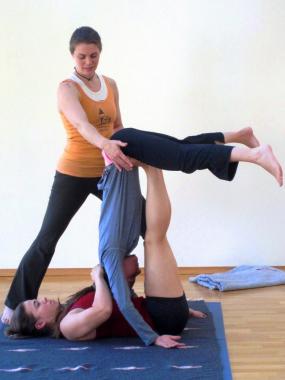Typically the first pose taught in Acro Yoga, folded leaf is the cornerstone of therapeutic flying. 
Base
As the flier steps into place, position your feet with toes turned out a couple inches below their anterior iliac crest (front hip bones). Offer your hands to the flier with fingers turned out and thumbs wide. Initially your legs are bent deeply and your arms are straight. Smoothly draw the flier’s weight into you by bending your arms drawing them more over you and as weight shifts into you straighten your legs. As the legs straighten allow the flier’s torso and head to dangle straight down over your belly, releasing their hands as soon as you feel comfortable with the balance. All the flier’s weight should go down through your straight legs and on into your sacrum. If however your legs can’t straighten due to tight hamstrings or low back rounding, place a folded blanket or towel beneath your sacrum a couple inches thick or so (as needed) to help alleviate this. Over time, your hamstrings will lengthen and your legs will straighten out. Once the flier is up, the arches of your feet should be comfortably cupping the flier’s upper thighs.
Flier
There are several ways to enter into folded leaf as the flier: holding hands, holding shins, or free falling are a few. First walk very close to your base such that your toes almost touch the base’s buttocks. Ensure their feet are turned out and below your hip bones a couple inches. Hold hands like you are about to do down dog (fingers forward), lean forward and allow your base to take your weight into their legs. As that happens, fold at the hips and take your legs wide (straddle) such that your head dangles over your base’s belly. Ideally your legs are parallel to the ground by making your toes heavy, or pressing down into your base’s feet. This is the only effort, pressing feet down, otherwise let your spine and arms dangle loosely from your hips. The art of trust begins here, let your base control your body. Do not touch the ground with open palms or press them into the ground. Do not lift your legs up into the air. Think padottanasana, a wide legged forward fold, with your torso and legs perpendicular to each other.
Spotter
Standing at the side with hands around (but not touching) the fliers hips, here the spotter begins to learn the art of spotting. Touching only when needed to prevent falls or injury, staying present and aware with what the base and flier are doing, and staying out of the way as they move is the art of being a great spotter! If they do tip, either 1) help them back to centered balance or 2) help the flier safely return to the earth, preferably on their feet. =) Another job for the spotter is to help guide the base and flier. If the base’s legs are not straight up and down (vertical) tell them which direction to move their feet to straighten them out. If the flier’s legs start to lift up tell them to bring their feet down or be more “toe heavy.” You can also act as a go-between for communicating if flier and base can’t hear each other.